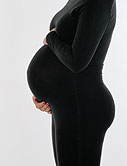
WEDNESDAY, May 8 (HealthDay News) — Among women who undergo in vitro fertilization (IVF) to become pregnant, there is no difference in delivery rates among those implanted with one prescreened embryo compared to those implanted with two unscreened embryos, new study findings reveal.
Although transferring two unscreened embryos is currently a more standard procedure, transferring a single chromosomally normal embryo results in fewer twins and better outcomes for both women and their babies, the researchers pointed out in a news release from the American College of Obstetricians and Gynecologists.
“The technology exists today to make single-embryo transfer the standard of care across age groups, eliminating the vast majority of complications stemming from IVF, while maintaining excellent delivery rates for couples who have struggled with infertility,” study lead researcher Dr. Eric Forman, of UMDNJ-Robert Wood Johnson Medical School/Reproductive Medicine Associates of New Jersey in Basking Ridge, said in the news release.
The study involved 175 women aged 43 or younger. The women were assigned to receive one genetically prescreened embryo or undergo a double-embryo transfer with no screening. The study showed the two groups had equal pregnancy rates. The researchers noted, however, that no twins resulted from the single-embryo transfer.
Meanwhile, 53 percent of the double-embryo transfers were multiples. Infertility treatments, such as IVF, generate 18 percent of all twin deliveries in the United States, the study authors added.
The research also revealed that transferring one prescreened embryo resulted in a longer gestation, on average. But double-embryo transfers were associated with a threefold increased risk of preterm delivery, the findings showed.
The single-embryo transfers were also associated with greater newborn birth weight, as well as fewer admissions and shorter stays in the neonatal intensive care unit.
The researchers pointed out that most women choose to have two embryos transferred because they may feel it increases the likelihood that they will become pregnant. Medical costs may also play a role because IVF is not always covered by insurance.
Now, only 10 percent of women opt for a single-embryo transfer. However, as more women learn about the success rates of single-embryo transfer, it may become a more popular option, Forman noted.
“[Single-embryo transfer] with comprehensive chromosome screening has the potential to be paradigm-shifting and revolutionary in the world of IVF,” Forman suggested in the news release.
“Patients can do [single-embryo transfer] and maintain excellent delivery rates while not taking on the treatment-related risk of multiples. And for [obstetrician-gynecologists], this will mean fewer high-risk pregnancies handed off to them. It can reduce the health care burden across the spectrum,” Forman said.
The study authors noted that the genetic screening used in the study is not yet widely available in the United States. They said this will likely change in the near future.
The study was scheduled for presentation Wednesday at the annual meeting of the American College of Obstetricians and Gynecologists in New Orleans. Research presented at medical meeting should be viewed as preliminary until published in a peer-reviewed journal.
More information
The U.S. Department of Health and Human Services has more about IVF.

